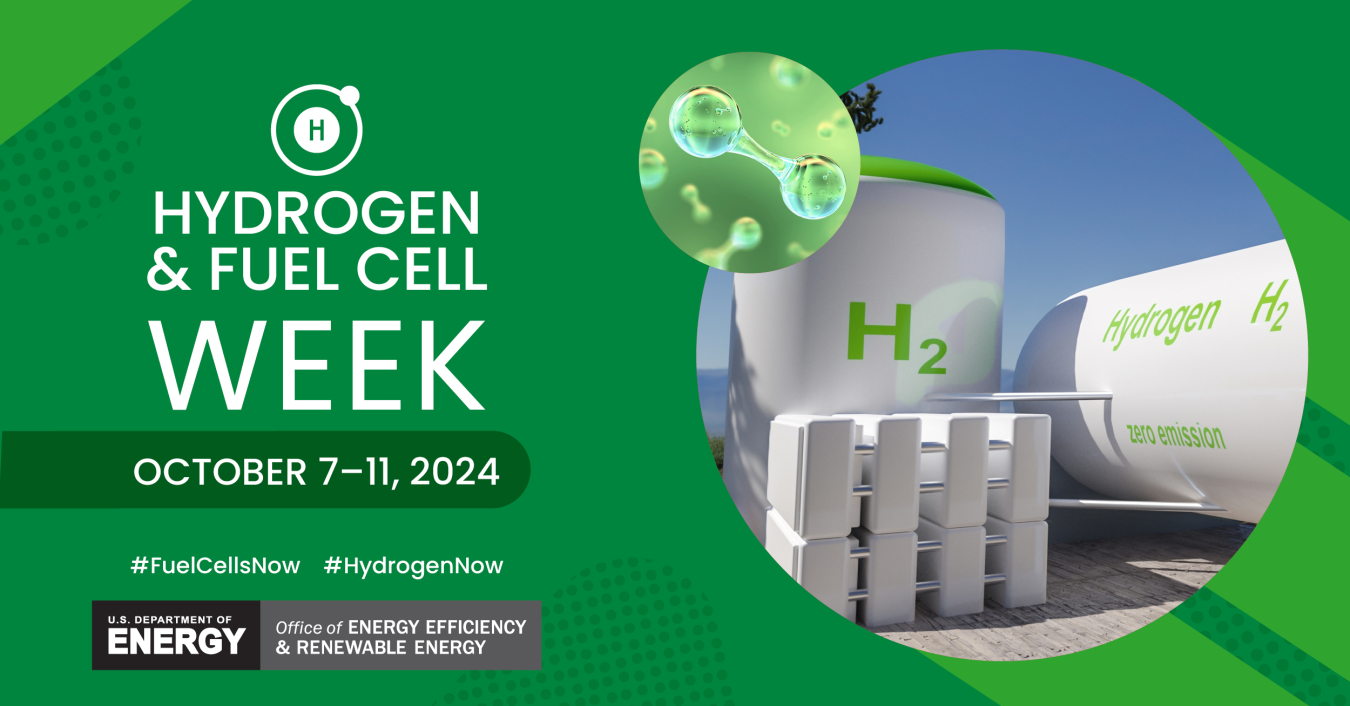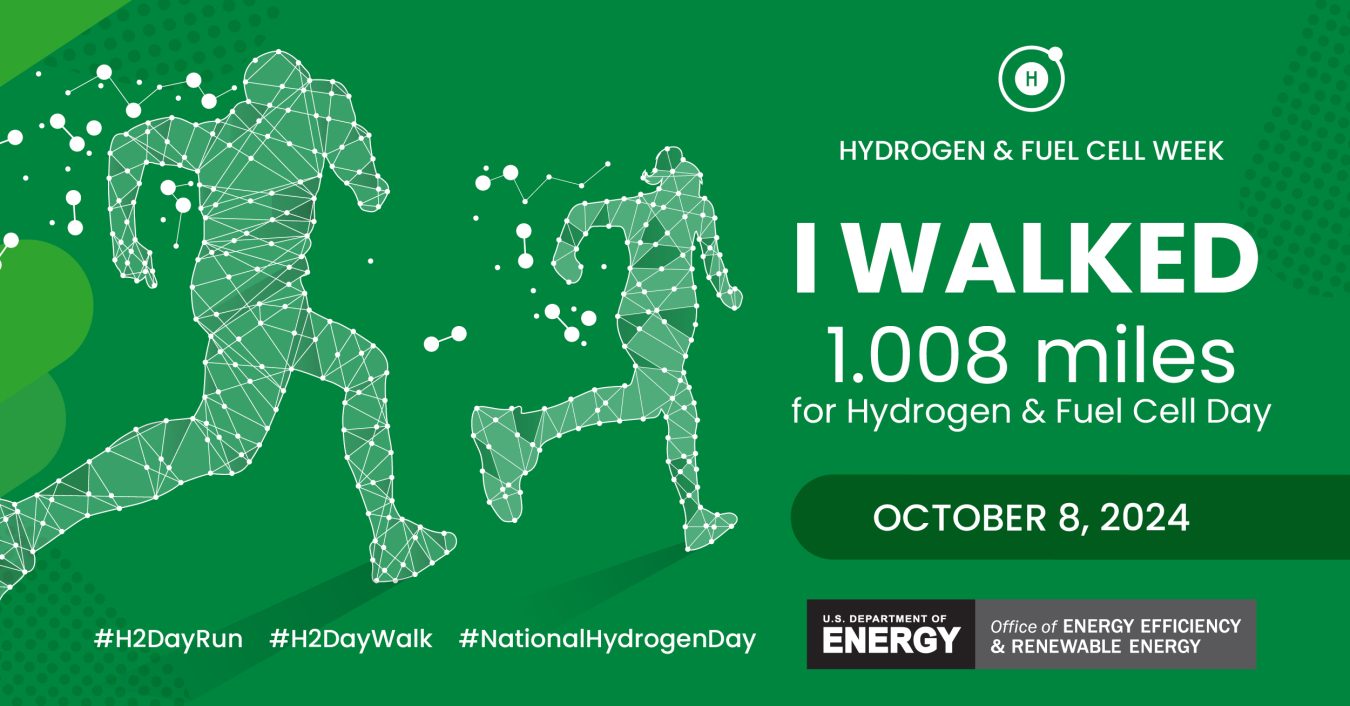Each year, the clean hydrogen community eagerly counts down the days to October 8. Why? Because 10/08 = 1.008, the same sequence of numbers as the atomic weight of hydrogen! And the U.S. Department of Energy is keeping the fun rolling all week long.
Hydrogen and Fuel Cell Technologies Office
October 7, 2024Welcome to Hydrogen Week 2024—Celebrating National Hydrogen and Fuel Cell Day All Week Long!

Each year, the clean hydrogen community eagerly counts down the days to October 8. Why? Because 10/08 = 1.008, the same sequence of numbers as the atomic weight of hydrogen!
October 8—National Hydrogen and Fuel Cell Day—is like a birthday party for hydrogen. And best of all, the U.S. Department of Energy (DOE) keeps the fun rolling all week long.
Hydrogen Week marks an annual opportunity to celebrate hydrogen—clean hydrogen, specifically—and the crucial role this simple yet powerful element plays in supporting a robust, equitable clean-energy future for all Americans.
To kick things off, let's look at some key facts about hydrogen in America today.
- Hydrogen is already essential to our everyday lives. We may not interact with it directly every day, but hydrogen is used in industrial and chemical applications such as petroleum refining and fertilizer production—important processes that are essential to our quality of life. Hydrogen is also used in food processing, steel manufacturing, and cosmetics.
- Hydrogen is hard at work moving goods and people. Hydrogen has a growing role in transportation and material-handling applications, with more than 70,000 hydrogen-powered forklifts already moving consumer goods in America's warehouses and growing investments in clean hydrogen for heavy-duty transportation like long-haul trucks and transit buses.
- We're transitioning quickly to clean hydrogen. Our national goal is to produce 10 million metric tons per year of clean hydrogen by 2030. Clean hydrogen is produced with low or zero emissions, using renewables, nuclear power, or fossil resources with carbon capture.
- We're going to produce and use much more clean hydrogen. Our national clean hydrogen strategy sets an ambitious target of producing 50 MMT per year of clean hydrogen in the United States by 2050, which will be essential for achieving the White House’s bold and important goal of a net-zero-emissions economy by that same year.
- Advanced hydrogen technology is being deployed across the country. Today we have 4.5 gigawatts of electrolyzers—which produce hydrogen from water and electricity—being built or already operational. That is 25 times more than what we had in 2021.
There are plenty of fun and educational activities you can do to celebrate Hydrogen Week.

Hydrogen and Fuel Cell Day Walk 2024. DOE colleagues celebrate Hydrogen and Fuel Cell Day each year with a brisk lunchtime walk of 1.008 mile (yes, we track the exact distance on our smartphones). And we promise to share photos on social media. You are encouraged to do the same in your neighborhood or workplace—in fact, if you’re feeling especially energetic and you have the time, make it 10.08 miles! Then show off with a social media post tagging #H2DayWalk or #H2DayRun with a picture and one of our awesome H2 walk/run graphics or a customized certificate!
Take part in a live community forum session focused on clean hydrogen. One of the more exciting tools DOE has revealed in the past year is the public forums platform, which helps regional stakeholders engage with communities on the impacts, benefits, and opportunities of clean energy deployment. You are invited to join a live demonstration of the Harnessing Hydrogen forum today (October 7) at noon ET—register now!
Interested in a broad introduction to the clean hydrogen economy? The Hydrogen Education for a Decarbonized Global Economy (H2EDGE) program, supported by DOE and managed by the Electric Power Research Institute, will host a two-day virtual learning session October 8 and 9. This five-part session will explore a broad range of clean hydrogen topics, from production to economics to end use markets and applications.
Get active, get social. Follow EERE on Facebook, X, and LinkedIn and share a photo or post. Maybe even add something new and interesting you've learned about hydrogen. Don't forget to tag #NationalHydrogenDay #HydrogenNow and #FuelCellsNow in your post.
Get smarter about clean hydrogen. Increase your H2IQ by accessing valuable DOE resources, including fact sheets, introductory materials, and multimedia— including an overview video from Energy Secretary Jennifer Granholm. Speaking of facts about hydrogen—did you know that 10% of your body weight is composed of hydrogen? Learn more hydrogen facts from our hydrogen and fuel cells posters!
Test your knowledge. Take our updated 12-question Hydrogen Quiz and see how much you know, and how much there is to learn about the universe's most abundant element. Take a screenshot of your quiz results and share on social media!
Stay informed and up to speed. Subscribe to Hydrogen and Fuel Cell Technologies Office (HFTO) news for the latest updates on clean hydrogen and fuel cell research and receive invites to webinars and events throughout the year.
Ready for a deeper dive? The U.S. National Clean Hydrogen Strategy and Roadmap released in 2023 explores detailed ways in which clean hydrogen can contribute to national decarbonization goals across the economy.
The federal government is making unprecedented investments to overcome all the barriers to clean hydrogen today—from advancing technologies in the laboratory, to deploying them in the field, to addressing safety and environmental concerns and ensuring the benefits of clean hydrogen are shared equitably across all communities. The Hydrogen Interagency Task Force (HIT)—a historic collaboration across numerous federal agencies—will further advance a whole-of-government approach to executing the national strategy. DOE's Hydrogen Program, led by HFTO, is a proud member of that task force. Read more about the HIT, the DOE Hydrogen Program, and HFTO.

